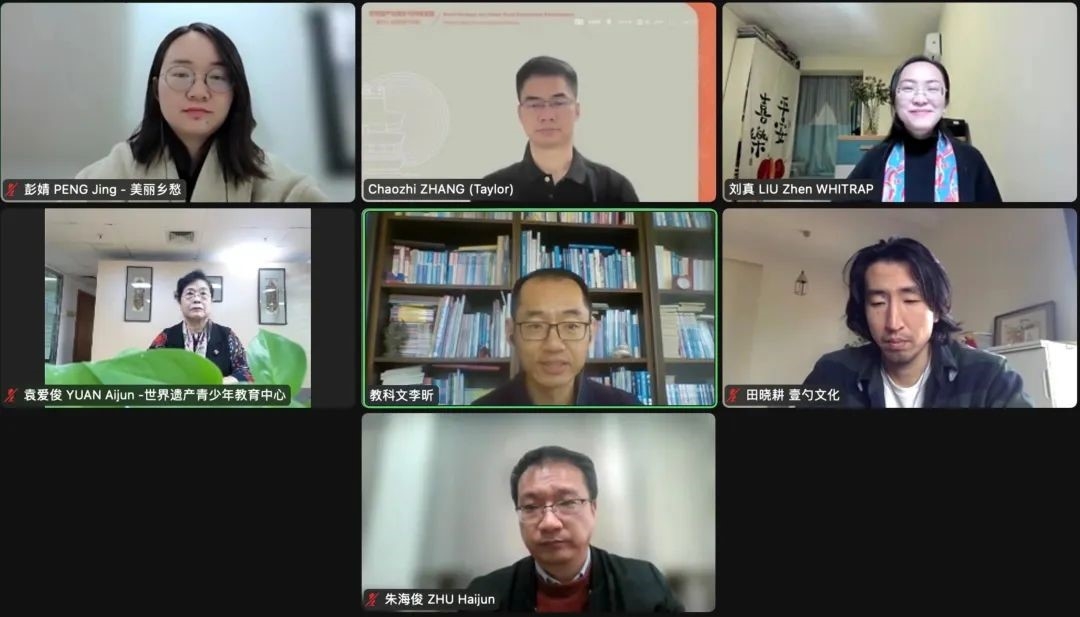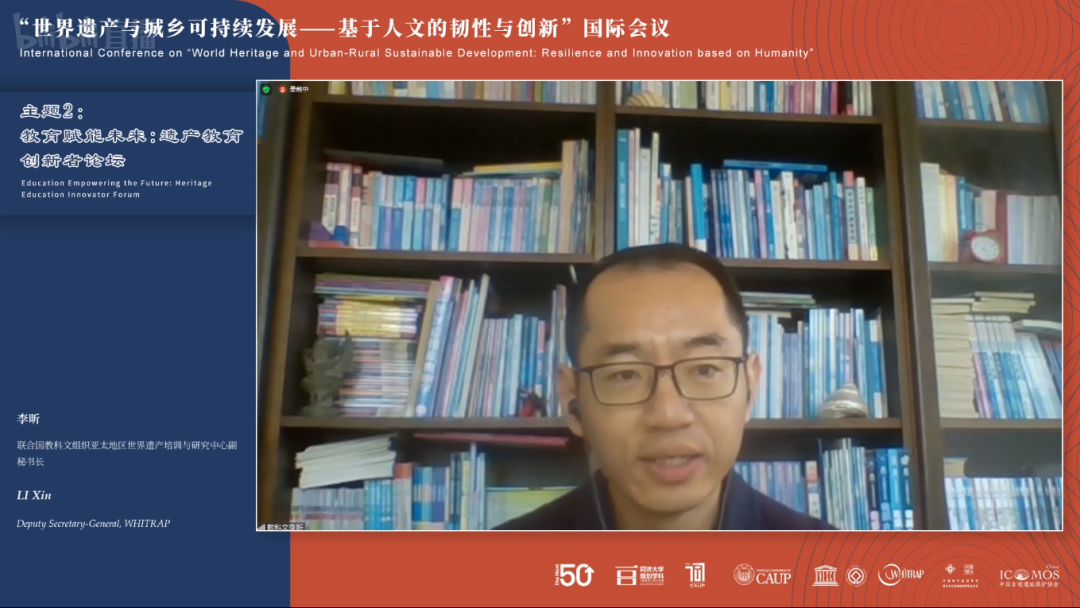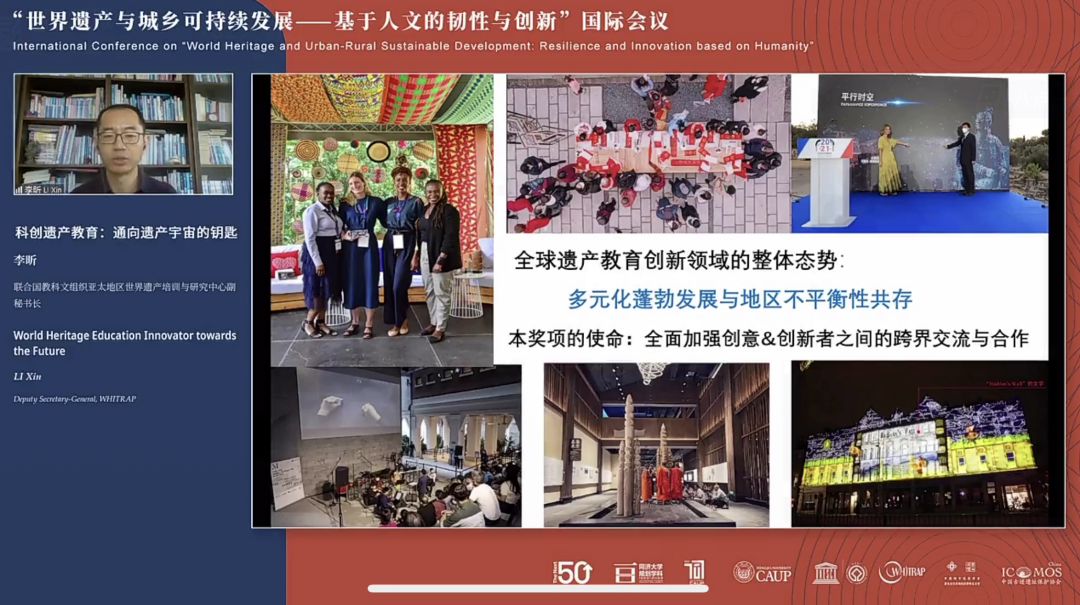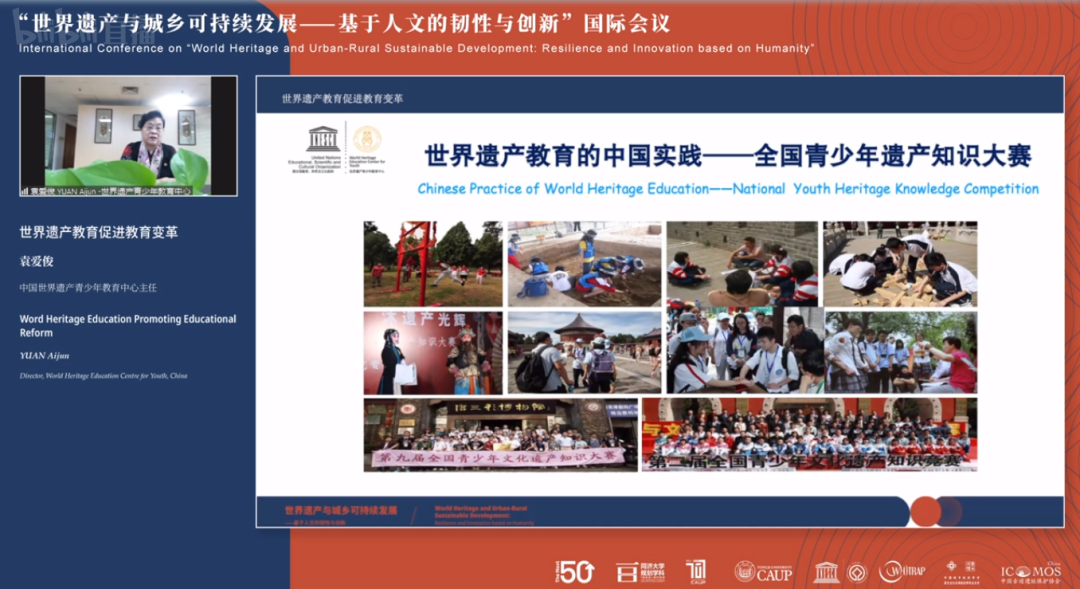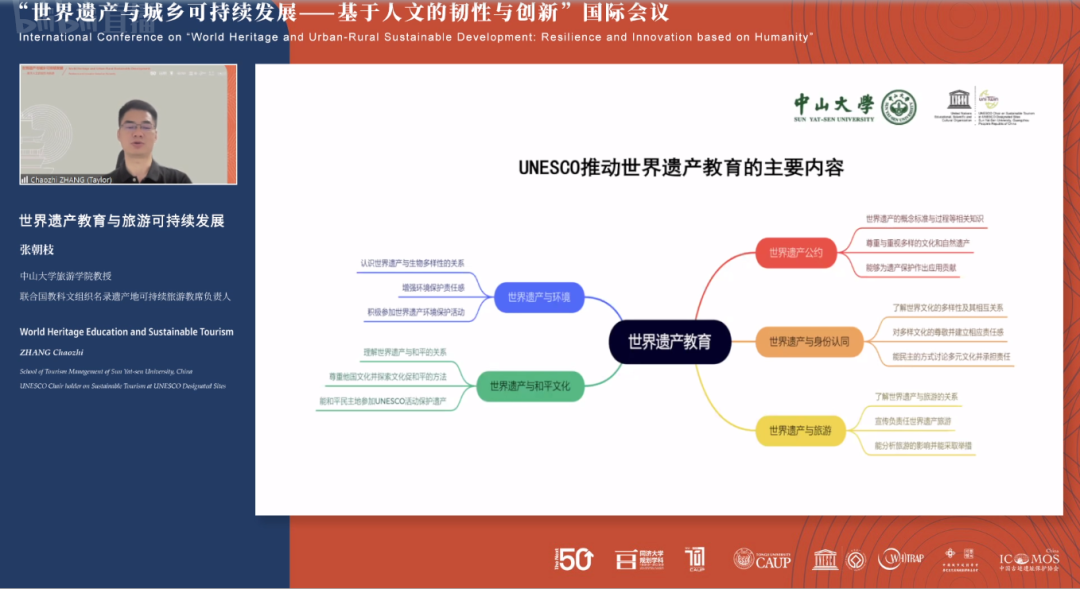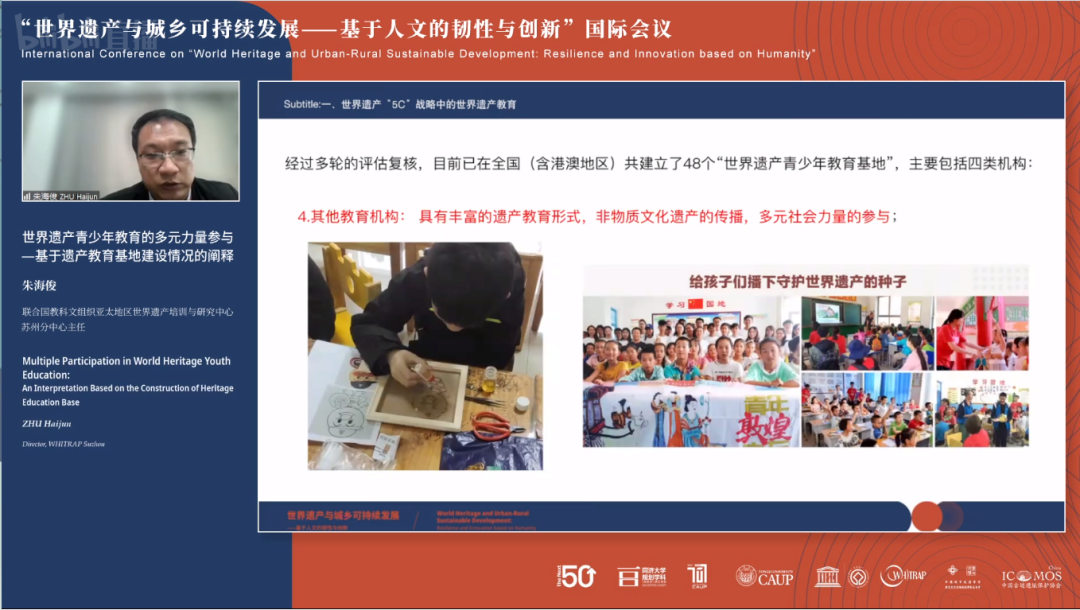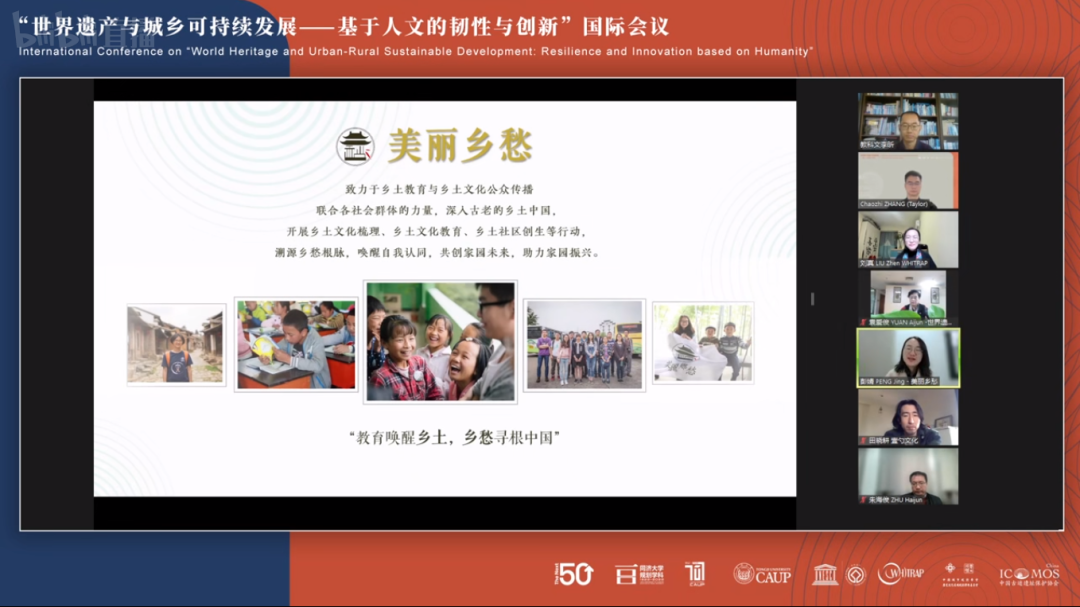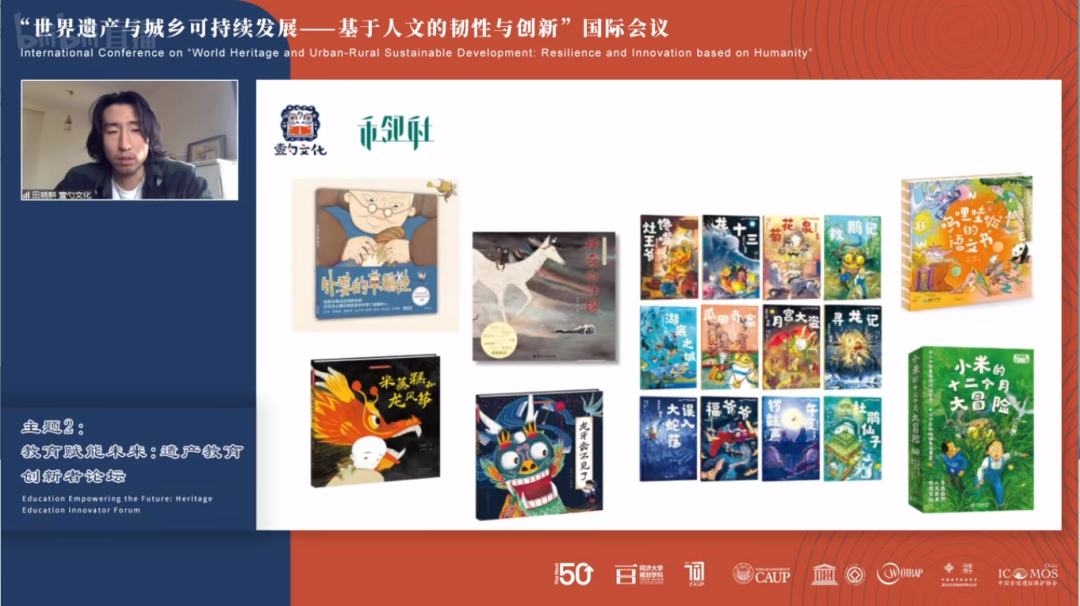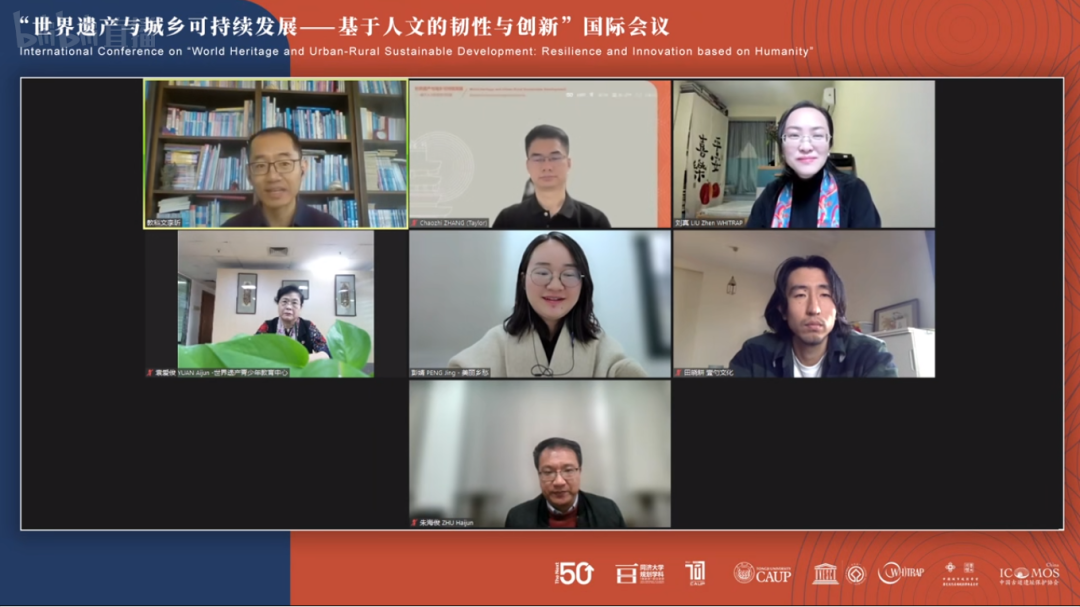| Highlights of Topic 2 at the Conference |
| PublishDate:2022-12-05 Hits:5910 |
On November 15thand 16th, CAUP of Tongji University, World Heritage Institute of Training and Research for the Asia and the Pacific Region (WHITRAP Shanghai) the Academic Committee for Conservation Planning of Famous Historical and Cultural City – Urban Planning Society of China, and ICOMOS China, successfully held an online international conference on “World Heritage and Urban-Rural Sustainable Development: Resilience and Innovation based on Humanity”, commemorating the 50th Anniversary of the World Heritage Convention, the40th Anniversary of China’s National Famous Historical and Cultural Cities Protection System. The review is the summary of the second sub-forum of the conference: Education Empowering the Future: Heritage Education Innovator Forum. World Heritage education is not only an important way for people to gain knowledge and inspiration, but also an incubator for innovative development models of heritage sites. At this critical moment of the 50th anniversary of the World Heritage Convention, reviewing the past and present and looking into the future of world heritage education, analyzing the opportunities and challenges ahead in a new era, sharing practical experience in innovative development of World Heritage education, and promoting the these practice modes, are all important topics to achieve the sustainable development of World Heritage education and the empowerment of heritage sites through heritage education. This session was chaired by Li Xin, the Deputy Secretary-General of WHITRAP. The session invited Yuan Aijun, Director of World Heritage Education Center for Youth, China, Zhang Chaozhi, professor of School of Tourism Management of Sun Yat-sen University and UNESCO Chair holder on Sustainable Tourism at UNESCO Designated Sites and Zhu Haijun, Director of WHITRAP Suzhou to deliver keynote speeches.
Liu Zhen, Program Specialist of WHITRAP Shanghai, Co-planner of Pingyao Story Series Picture Book Program and Ripple Action Youth Heritage Volunteer Program, Peng Jing, Co-founder of Beautiful Nostalgia and Co-sponsor of Ripple Action Youth Heritage Volunteer Program, Tian Xiaogeng, Founder of Shanghai Yishao Creative Studio and Co-planner of Pingyao Story Picture Book Program participated in the discussions.
Group Photo © Zhan Jingfang
1.Introduction to the Topic
Dr. Li Xin first introduced the theme of this sub-forum, which focused on youth heritage education and many innovative practitioners who have explored the frontier in the field were invited to share their experiences in the development and promotion of innovative practice regarding heritage education.
Li Xin: Introducing the Theme© Pan Minjie
2. A clip of “2021 Global Awards for World Heritage Education Innovative Cases”
As the chief planner of the Global Awards for World Heritage Education Innovative Cases”, Dr. Li Xin introduced the award and the winners of 2021. He also summarized the future trend of global heritage education. This video brought together heritage education innovation cases from different countries and regions around the world, showcasing the exemplary cases in the frontier of world heritage education, thus providing a framework of reference for future heritage education innovators.
3.Keynote Speeches (1) “Scientific and Creative Heritage Education: The Key to the Heritage Universe” by Li Xin To tackle the challenges and opportunities brought by the intelligence era to the World Heritage Education, Dr. Li Xin put forward the concept of “Heritage Universe”. Unlike the Metaverse, which cannot reflect the limitation of in-depth information in reality, the “Heritage Universe” contains endless natural and cultural heritage values, including the most unique essence of human civilization, which cannot be replicated and restored by the technology of artificial intelligence. The goal of heritage education is to better understand and tap the value of the heritage universe. The scientific and creative heritage education is the key to innovation in heritage education.
China's heritage sites are rich in resources, but their distribution is scattered. At present, channels are lacking for linking the external resources and for cross-border and cross-regional exchanges. This is a major bottleneck for the innovation of heritage education models in the current transformation and upgrading period. In order to break the bottleneck, building an international interactive communication platform that connects cultural heritage resources and high-end cultural and creative resources to facilitate internal and external communications, and focusing on the innovation of World Heritage education models is the core strategy for the transformation and upgrading of heritage protection and utilization models.
Dr. Li Xin pointed out that based on the cases applying for the “2022 Global Awards for World Heritage Education Innovative Cases”, many innovative scenarios and utilization methods have emerged in a global scale, with more diverse social participation and r formats and themes. However, the development gap within and between the regions is widening. The overall trend in global heritage education is a concurrent state of diversified and vigorous development and regional imbalances. We have the obligation to integrate different strengths to promote a balanced development, cross-border exchanges and cooperation around the world. It is the best way to innovate the development model of heritage sites by making use of the opportunity provide by heritage education.
Li Xin: Scientific and Innovative Heritage Education: the Key to the Heritage Universe © Pan Minjie
(2) World Heritage Education Promoting Education Reform by Yuan Aijun Yuan Aijun, Director of World Heritage Education Center for Youth, China, gave a speech on the topic of “World Heritage Education Promoting Education Reform” when Chinese education met World Heritage. The latter illuminated the road to China’s education reform, and provided new ideas for solving global crises. Her speech analyzed the transformative role of World Heritage education in China’s youth education system and its leading role in solving global development problems.
First, the Chinese government attached great importance to cultural heritage, which promoted the development of World Heritage Education. It gave Chinese teenagers a new perspective on Chinese history and culture.
Second, introducing World Heritage Education into campuses consolidated the values of World Heritage Education and enriched its connotation. World Heritage Education promoted education reform and development, enabling Chinese education to explore a new way and to open a new realm to of cultural awareness and confidence.
Third, the dissemination and promotion of the World Heritage Education models also contributed to the educational issues related to world development. Facing the problems and challenges of the sustainable development, making young people aware of the common threats facing mankind is a new path to solve the global crisis.
Yuan Aijun: World Heritage Education Promotes Educational Change © Pan Minjie
(3) World Heritage Education and Sustainable Tourism by Zhang Chaozhi Zhang Chaozhi, a professor of School of Tourism Management of Sun Yat-sen University, delivered a speech centering on “World Heritage Education and Sustainable Tourism”.
He started with the main activities and format of UNESCO to promote World Heritage Education, and briefly described its development and characteristics in China, including: using World Heritage Education as an important carrier to promote the all-round development of students; promoting the knowledge and incorporating concepts of World Heritage into the curriculum and teaching materials; taking world heritage education as an important way to promote students' social practice and stressing the combination of in-class teaching and extracurricular practice in World Heritage Education.; World Heritage Education is an important part of international exchange and cooperation in education. It also witnessed the combination of World Heritage Education with the cultivation of high-quality talents and with teaching and scientific research.
The report pointed out that World Heritage Education is also an important part of study tours, and vice versa, the latter is also a form of world heritage education. Study tours in World Heritage sites has brought changes to the tourism market and guided the behavior of tourists. Local communities have used local knowledge as a capital asset to participate in these tours, which has changed the livelihood of the community. Heritage management departments have also transferred professional knowledge of World Heritage as a tool FOR community governance, which effectively promotes the sustainable development of World Heritage Sites. Therefore, study tours as an integrated part of World Heritage education have signified a major direction for the protection and utilization of heritage sites and the sustainable development of tourism as well in the future.
Zhang Chaozhi: World Heritage Education and Tourism Sustainable Development © Pan Minjie
(4) Multilateral Participation in World Heritage Youth Education, by Zhu Haijun Zhu Haijun, Director of WHITRAP Suzhou, shared the experiences and outcomes of building World Heritage Youth Education Base in China. He started with the way to implement the “5C” strategic objectives of UNESCO. According to the “5C” strategy, the core of the heritage value lies in its significance to people in the modern era. Heritage education actually enables to better use these values through promotion, education and community participation.
The report pointed out that heritage education requires the participation of UNESCO, heritage sites, youth education institutions, heritage protection research institutions, relevant industry practitioners, and volunteers. Each party has to give full play to their advantages to promote the protection and spreading of heritage values. At present, WHITRAP’s “World Heritage Youth Education Base” includes various primary and secondary schools, heritage sites, cultural and museum institutions, and educational institutions. With a variety of strengths, the exploration of World Heritage Education has improved public’s awareness of protecting world heritage sites, enhanced the equal opportunity among youth to have access to heritage education and promoted the development of World Heritage in general. On the basis of the participation of multiple parties, it is also important to promote the establishment standards, to further disseminate training concepts and methods, and to cooperate with creative sci-tech institutions for the development of future.
Zhu Haijun: Diversified Forces in World Heritage Education for Youth © Pan Minjie
4.Roundtable Discussion
In roundtable discussion, Liu Zhen, Peng Jing and Tian Xiaogeng shared the practices and experience of Ripple Action Youth Heritage Volunteer and Pingyao Story Picture Book programmes and other heritage education activities carried out by Beautiful Nostalgia and Yishao Creative Studio. They proposed innovative education models which involved urban-rural interaction, youth participation, and heritage aesthetic education, etc. They also stressed how to use the strength of platform in heritage education to mobilize internal and external resources for quick innovative development. In particular, they emphasized that the programmes are committed to lowering participation threshold and removing other obstacles for a wider participation. Young people have become an important power in the development of innovative World Heritage education in the future. Heritage empowers youth and vice versa.
Professor Zhang Chaozhi pointed out that the lack of internal driving force among heritage education institutions caused unsustainable operations and became the major bottle neck to promote heritage education projects. And creative practitioners should make full use of their professional backgrounds, brought in the advantageous resources of heritage sites, educational institutions, experts and scholars, government departments, and the public, to establish a bottom-up and spontaneous development model. Thus, together with suitable business models and market forces, the value of cultural heritage will be fully released to form a shared heritage education pattern featuring co-creation, and co-construction.
Yuan Aijun emphasized that to do heritage education and cultural dissemination, itis necessary to find the correct values and not be solely driven and seduced by utilitarian purposes. Professional institutions such as UNESCO should lead the formation and implementation of these cultural values, and cooperate with schools to make those values reach to teachers and students, and the power of education will be fully exerted.
Peng Jing: Sharing the Experience of Beautiful Nostalgia
Tian Xiaogeng: Sharing the experience of Yishao Creative Studio
At the end of the discussion, Dr. Li Xin invited the guests to look forward to the next 50 years of World Heritage education and used one sentence to end the session.
Yuan Aijun said at the 50th anniversary of the Word Heritage Convention, China has embarked on a unique path of Chinese heritage education. I think China's heritage education will have greater development, and it will also showcase the outcomes of China's education reform on the world education stage.
Professor Zhang Chaozhi stated that the future will see the promoting of the sustainable development of heritage sites through heritage education, and the integration of tourism and heritage through creative tourism experience. Let's work together for the future of World Heritage Education.
Zhu Haijun pointed out that we are full of confidence in the future of World Heritage education. We are also aware that more things have be done. We will always rely on our innovative and open minds to jointly promote the sustainable development of World Heritage education and to inspire its potential.
Liu Zhen said that Heritage is a gift of time, and education is a person’s lifelong mission. We are not only a beneficiary of heritage education, but also a co-creator and actor of heritage education. Weare looking forward to going forward together.
Peng Jing expressed her hope to work with more young people to stir up more ripples in the process of heritage education and heritage promotion, so that all actors will be able to meet in places, meet the local heritage, and meet each other.
Tian Xiaogeng stated that what we are facing is the future of heritage education. The imaginative space for the future of World Heritage education lies in how we choose to inherit, learn and innovate.
Round Table Discussion © PAN Minjie
5.Summary of Sub-forms
The roundtable discussion provided a platform for in-depth communication and knowledge sharing among innovative practitioners of World Heritage youth education. Participating experts and explorers shared their experience in World Heritage education and discussed the future development and trend as well. The main outcomes included the following three points:
(1) Building an international platform for exchange that connects cultural heritage with other high-end cultural and creative resources to internal and external facilitate communications, and focusing on the innovation of World Heritage education models is the core strategy for the transformation and upgrading of heritage protection and utilization models.
(2) The overall trend in global heritage education is a concurrent state of diversified and vigorous development and regional imbalances. We have the obligation to integrate strengths to promote a balanced development and cross-border exchanges and cooperation. This is the best way to promote the innovation in development model of heritage sites around the world with the opportunity heritage education has provided.
(3) Heritage education is facing a period of major reform and innovation. Thereare new forces in the fields of cultural tourism, cultural and creative development, primary and secondary education institutions, and local governments to promote this trend of innovation and reform. We believe that the future of heritage education will be better.
Contributed by WANG Tianxiang ZHAN Jingfang (Intern) Translated by LI Wenchun(Intern) Typest by ZHANG Yuzhuo (Intern) JI Zhenjiang(Intern)
|
- News | WHITRAP Shanghai and CNR-ISPC bilateral meeting
- News | WHITRAP meets Cité de l’Architecture et du Patrimoine
- WHITRAP Hosting "Workshop on Preliminary Assessment for National Focal Points of the Asia Region" in Chengdu
- WHITRAP Shanghai meets UNESCO
- INTERNATIONAL CONFERENCE PRELIMINARY ANNOUNCEMENT & CALL FOR PAPERS
- Observation of the 46th Session of the World Heritage Committee
Copyright © 2009-2012 World Heritage Institute of Training and Research-Asia and Pacific (shanghai)


